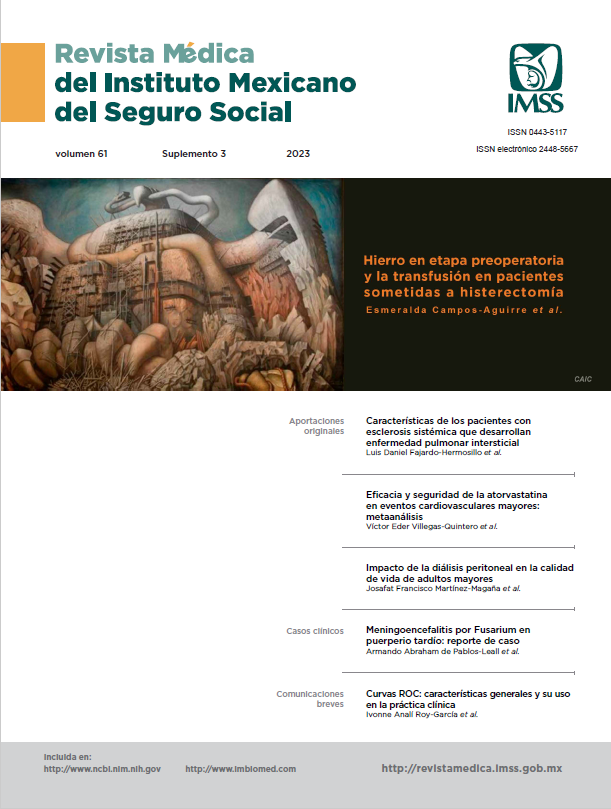Dental occlusal disruptor as a strategy to moderate caloric intake: two case report
Main Article Content
Keywords
Overweight, Body Weight, Obesity, Prosthesis, Orthotic Devices, Dental Occlusion
Abstract
Background: Obesity is a global public health challenge, closely related with the progression of other diseases. In recent years, odontology has intervened against obesity through the implementation of intraoral devices that contribute with weight control treatments.
Objective: To study the use of a dental occlusal disruptor as a strategy to moderate caloric intake.
Material and methods: Pilot study which included 2 patients. It was used a dental occlusal disruptor that has an impact on the smaller amount of food at each bite. Patients attended five appointments in which a stomatological evaluation was carried out and anthropometric measurements were taken. All adverse effects were reported in each patient’s clinical history.
Results: Patients presented weight and body fat loss, increased muscle mass and decreased both body mass index and waist and hip measurements.
Conclusions: The use of the disruptor does not alter the stomatological assessment, it promotes masticatory regulation and the decrease in body weight. It is necessary to analyze its use in a larger number of patients.
References
Barrera-Cruz A, Rodríguez-González A, Molina-Ayala MA. Escenario actual de la obesidad en México. Rev Med Inst Mex Seguro Social. 2013;51(3):292-9.
Franco S. Obesity Update 2012. USA: Organization for the Economic Cooperation and Development; 2012. Disponible en: https://www.oecd.org/health/49716427.pdf.
Stevens G, Dias RH, Thomas KJ, Rivera JA, Carvalho N, Barquera S, et al. Characterizing the epidemiological transition in Mexico: national and subnational burden of diseases, injuries, and risk factors. PLoS Med. 2008;5(6):e125. doi: 10.1371/journal.pmed.0050125.
Secretaría de Salud. Documentos Analíticos de ENSANUT 2018 Obesidad en México, prevalencia y tendencias en adultos. México: Secretaría de Salud; 2018.
Ramage S, Farmer A, Eccles KA, McCargar L. Healthy strategies for successful weight loss and weight maintenance: a systematic review. Appl Physiol Nutr Metab. 2014;39(1):1-20. doi: 10.1139/apnm-2013-0026.
Kassir R, Debs T, Blanc P, Gugenheim J, Ben Amor I, Boutet C, et al. Complications of bariatric surgery: Presentation and emergency management. Int J Surg. 2016;27:77-81. doi: 10.1016/j.ijsu.2016.01.067.
Arterburn DE, Telem DA, Kushner RF, Courcoulas AP. Benefits and Risks of Bariatric Surgery in Adults: A Review. JAMA. 2020;324(9):879-87. doi: 10.1001/jama.2020.12567.
Rivera Dommarco JA, Aguilar Salinas, CA, Hernández Ávila M. Obesidad en México: recomendaciones para una política de Estado. México: Universidad Nacional Autónoma de México; 2015. 431 pp.
Syn NL, Cummings DE, Wang LZ, Lin DJ, Zhao JJ, Loh M, et al. Association of metabolic-bariatric surgery with long-term survival in adults with and without diabetes: a one-stage meta-analysis of matched cohort and prospective controlled studies with 174772 participants. Lancet. 2021;397(10287):1830-41. doi: 10.1016/S0140-6736(21)00591-2.
Knoderer WR, inventor. Mandibular lateral motion inhibitor. United States patent US 4,727,867. 1988.
Brown SJ, inventor. Dental appliance for weight control. United States patent 4,738,259. 1988.
Blesser EW, inventor. Mouth appliance for assisting in weight control. United States patent 4,883,072. 1989.
Stubbs JM, inventor. Device for controlling eating and smoking habits. United States patent 5,052,410.1991.
Costigan HS, inventor. Lose at the source plate. United States 20060185679 AL. 2006.
Gómez-Robledo M. Graparse la lengua para adelgazar. Periódico El País; 13 de marzo de 2015: Sección Internacional. 2015. Disponible en: https://elpais.com/internacional/2015/03/13/ actualidad/1426216289_007595.html.
Pausé C, McAllister TG, Simpson AB, Graham R, Calloway L, Gillon A, et al. Teeth are for chewing: a critical review of the conceptualisation and ethics of a controversial intraoral weight-loss device. Br Dent J. 2021;231(11):675-9. doi: 10.1038/s41415-021-3680-x.
Von Seck P, Sander FM, Lanzendorf L, von Seck S, Schmidt-Lucke A, Zielonka M, et al. Persistent weight loss with a non-invasive novel medical device to change eating behaviour in obese individuals with high-risk cardiovascular risk profile. PLoS One. 2017;12(4):e0174528. doi:10.1371/journal.pone.0174528.
Brunton PA, Ratnayake J, Bodansky HJ, Mei L, Veerasamy A, Hall R. An intraoral device for weight loss: initial clinical findings. Br Dent J. 2021;1-6. doi: 10.1038/s41415-021-3081-1.
Jackson VM, Breen DM, Fortin JP, Liou A, Kuzmiski JB, Loomis AK, et al. Latest approaches for the treatment of obesity. Expert Opin Drug Discov. 2015;10(8):825-39. doi:10.1517/174 60441.2015.1044966.
Chang J, Brethauer S. Medical Devices in the Treatment of Obesity. Endocrinol Metab Clin North Am. 2016;45(3):657-65. doi: 10.1016/j.ecl.2016.04.014.
Lew D, Thampy C, Hawasli A. Lack of efficacy of dual intragastric balloon therapy on weight loss and patient dissatisfaction. Am J Surg. 2021;221(3):581-4. doi: 10.1016/j.amjsurg.2020.11.010.
Sarr MG, Billington CJ, Brancatisano R, Brancatisano A, Toouli J, Kow L, et al. The EMPOWER study: randomized, prospective, double-blind, multicenter trial of vagal blockade to induce weight loss in morbid obesity. Obes Surg. 2012;22(11):177182. doi: 10.1007/s11695-012-0751-8.
Swei EC, Sullivan SA. Aspiration Therapy. Tech Vasc Interv Radiol. 2020;23(1):100659. doi: 10.1016/j.tvir.2020.100659.
Food and Drug Administration. 21 C.F.R. § 812.2(c) 2022. Disponible en: https://www.accessdata.fda.gov/scripts/cdrh/ cfdocs/cfcfr/CFRSearch.cfm?CFRPart=812&showFR=1.
Norma Oficial Mexicana NOM-241-SSA1-2021. Buenas prácticas de fabricación de dispositivos médicos. México: Diario Oficial de la Federación; 20 de diciembre de 2021. Disponible en: https://dof.gob.mx/nota_detalle.php?codigo=5638793&fec ha=20/12/2021#gsc.tab=0.
Magnusson T, Enbom L. Signs and symptoms of mandibular dysfunction after introduction of experimental balancing-side interferences. Acta Odontol Scand. 1984;42(3):129-35. doi: 10.3109/00016358408993863.
Riise C, Sheikholeslam A. Influence of experimental interfering occlusal contacts on the activity of the anterior temporal and masseter muscles during mastication. J Oral Rehabil. 1984;11 (4):325-333. doi: 10.1111/j.1365-2842.1984.tb00583.x.


